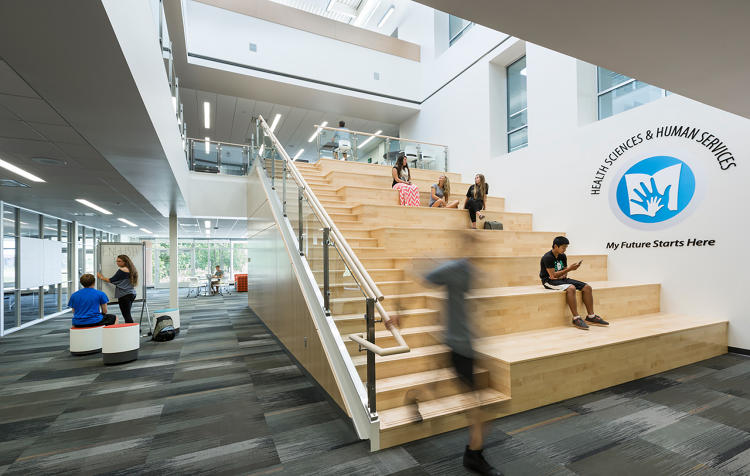
How To Design The Googleplex Of Schools
FAST COMPANY: When the city of Alexandria, Minnesota, asked community members what they wanted in their new high school to be like, they replied, “like the Google campus.” So they hired John Pfluger of Cuningham Group Architecture to make that a reality. Something that might not be the same size, or even necessarily have the exact design considerations, but that represents the same sense of possibility—the feeling of being adaptable to the future, whatever might come of it. The result is a state-of-the-art facility for more than 1,400 students where the word “classroom” is verboten, and where an hour in algebra class might be indiscernible from kicking back in the quad.
The new $73 million Alexandria Area High School houses students from grades nine to 12. In terms of square footage, the new facility is average in size—about 200 square feet per student—but “it plays bigger than it is,” says Pfluger, because of the layout. The new space is bright, open, social, and reconfigurable. It’s made up of six smaller, acoustically separate environments, which connect through an open area called the Community Commons, a combination cafeteria, theater, and social space. Everything is open, right down to walls made out of glass, while all of the furniture is designed to be easy to move around and reconfigure.
“Designing an environment that can take kids into an unknown future is a real challenge,” Pfluger tells me. “We know things are going to be more different in the future than we can possibly expect, so how do we address that uncertainty?” The answer: you design a high school that can transform.
What about classrooms? That’s the “c-word” at Alexandria Area High, Pfluger tells me. There are still classroom-like spaces, which are reconfigurable by swinging walls open or shut. But the major difference between Alexandria’s classrooms and the classrooms most high schoolers are used to is that teachers don’t own them. Instead, teachers shift to whatever space best suits the lesson at hand. For teaching geometry, maybe that’s a more traditional classroom, with a teacher standing at a blackboard in front; for learning about Shakespeare, though, class would be just as likely to convene on the Learning Stairs, an ampitheater-like sitting and presentation space.
Since students first started attending the new Alexandria Area High School facilities in fall, student engagement is at an all-time high. And while teachers have had to give up the private kingdoms of their classrooms for workstations in the teacher’s lounge, they like it a lot more too. “The fear is always that it’ll be the teachers, not the students, who are most resistant to change,” says Pfluger. “But in this case, that wasn’t true at all. These were teachers who couldn’t wait to bring the high school they taught in into the 21st century.”





